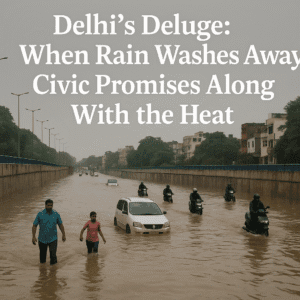Delhi’s Deluge: When Rain Washes Away Civic Promises Along With the Heat
Delhi’s monsoon chaos returned as Tuesday’s heavy rainfall submerged critical infrastructure, exposing persistent civic failures despite official assurances. The Zakhira underpass transformed into a six-foot-deep pool, halting traffic and revealing inadequate drainage—symbolizing systemic neglect. Across Windsor Place, Kirari, and Akshardham, waterlogged streets paralyzed commutes, turning roads into rivers and contradicting claims of monsoon preparedness.
While the rains cooled temperatures and dramatically improved air quality—bringing rare “satisfactory” AQI levels to NCR—these benefits were overshadowed by preventable disruption. Officials scrambled with malfunctioning pumps as residents endured gridlock, underscoring a cycle of unfulfilled promises. With IMD issuing Red and Yellow alerts for ongoing storms, Delhi faces days of further disruption, highlighting an urgent need for resilient urban planning beyond temporary fixes.

Delhi’s Deluge: When Rain Washes Away Civic Promises Along With the Heat
The heavens opened over Delhi on Tuesday, but the relief from the oppressive heat was swiftly drowned by a familiar urban nightmare. Heavy rainfall, while a welcome respite from sultry conditions, laid bare the city’s perennial struggle with monsoon management, transforming streets into rivers and commutes into grueling ordeals.
Beyond the 8mm of rain recorded by the IMD and the slight dip in temperature, the real story unfolded on the ground. The Zakhira underpass in North Delhi became a potent symbol of systemic failure, submerged under nearly six feet of water. Visuals captured the grim reality: vehicles abandoned, two-wheelers perilously navigating the floodwaters, and pedestrians – adults cautiously, children sometimes gleefully – wading through waist-deep murk. Despite Public Works Department (PWD) pumps deployed, one remained non-functional, a frustrating microcosm of the larger inefficiency.
Chaos Beyond Zakhira: A City Submerged
The chaos was far from isolated:
- Windsor Road: Large stretches vanished underwater, causing massive traffic snarls.
- Kirari: Poor drainage led to extensive flooding, forcing vehicles into a dangerous crawl.
- Akshardham: Stranded vehicles and serpentine queues painted a picture of commuter despair as stormwater stubbornly refused to drain.
This widespread disruption starkly contradicted repeated civic assurances of “monsoon-ready” drainage systems. Residents were left questioning the substance of pre-monsoon clean-up drives as promises dissolved faster than the rain could wash away the dust. The scenes were a harsh echo of Delhi’s recurring monsoon woes – a cycle of downpour, waterlogging, traffic paralysis, and hollow reassurances.
The Silver Lining: Cleaner Air, Cooler Relief
Amidst the frustration, the rain delivered tangible benefits:
- Temperature Tamed: The dip to 26.8°C offered genuine relief from the preceding heat and humidity.
- Air Quality Reborn: In a dramatic turnaround, dust and pollutants were scrubbed from the air. Areas like Noida, Greater Noida, and Ghaziabad saw AQI levels plunge into the ‘Satisfactory’ range – a rare and precious gift for a region notorious for its toxic air.
- Health Respite: Health experts highlighted this improvement as particularly crucial for vulnerable groups – the elderly, children, and those with respiratory conditions – offering a vital, albeit temporary, reprieve.
The Forecast: More Rain, More Vigilance Needed
The respite, or the chaos, isn’t over yet. The IMD has issued:
- A Red Alert for southeast and northeast NCR.
- A Yellow Alert for southwestern and southeastern parts of Delhi.
Expect cloudy skies and moderate rainfall to persist through the week, with thunderstorms and localized heavy downpours likely until August 3rd. Temperatures are expected to hover around a manageable 30°C. Nationally, heavy to extremely heavy rainfall is forecast across Northwest India (including East Rajasthan, Himachal Pradesh, Uttarakhand, Punjab, Haryana) and Western India (Konkan, Gujarat) until August 4th.
The Human Takeaway: Beyond the Headlines
Tuesday’s deluge was more than just a weather event; it was a stark stress test for Delhi’s urban infrastructure. It exposed the chasm between civic promises and on-ground reality, turning daily life into an obstacle course. While the cleansing rain brought cooler temperatures and cleaner air – genuine boons for public health – these benefits were overshadowed for many by the preventable chaos of waterlogging and gridlock.
The recurring nature of this crisis demands more than reactive pumping. It demands sustainable, long-term solutions to drainage, accountability for preparedness claims, and a recognition that for a megacity, resilience isn’t just about weathering the storm, but ensuring the storm doesn’t bring life to a standstill. Until then, Delhiites will continue to brace not just for the rain, but for the civic failures it inevitably reveals.
You must be logged in to post a comment.